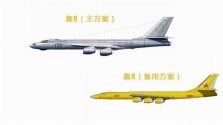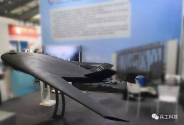The moment it goes nuclear hypersonics, ballistic missiles and nuclear submarines will do the trick, nuclear bombers are really no longer a required part of the nuclear triad. If anything, China needs a stealth missile truck which the H-20 could do well in if procured in the right numbers.I think PLA will use more drone for tactic purpose but it needs stealth strategic bomber so that US airforce doesn't think of using nukes. B21 must have raised serious alarm in PLA.
You are using an out of date browser. It may not display this or other websites correctly.
You should upgrade or use an alternative browser.
You should upgrade or use an alternative browser.
H-20 bomber (with H-X, JH-XX)
- Thread starter Deino
- Start date
Very reliable. Many subsystems of the H-20 are being tested.Has? Really??? So far all we know are rumours and speculations, in fact we have nothing
Very reliable. Many subsystems of the H-20 are being tested.
No-one denies this - otherwise no-one would expect its unveiling soon -, but we have NO proof for a V-tail nor for any of your mentioned points!
For a bomber to work as a missile truck, it has to be able to carry huge amounts of payload.The moment it goes nuclear hypersonics, ballistic missiles and nuclear submarines will do the trick, nuclear bombers are really no longer a required part of the nuclear triad. If anything, China needs a stealth missile truck which the H-20 could do well in if procured in the right numbers.
Good examples of this would be the B-1B (34 tons), B-52 (32 tons) and Tu-160 (40 tons).
Bombers like the B-2 could only carry 18 tons of payload at most. B-21 would have an even lower (estimated) 13-15 tons of payload capacity, so I wouldn't refer both of them as viable missile trucks.
At present, China does not have any bombers that could play the missile truck role - the H-6 only has a payload capacity of around 9 tons, which is smallest among her strategic bomber peers.
To be frank, in the 1970s and 1980s, China did brush pass a bomber proposal which technically can be regarded as China's own (albeit smaller) missile truck bomber, i.e. Xi'an H-8, with a payload capacity of around 18-20 tons. Below is an illustration of the H-8 design variants by @Deino.

Unfortunately, the proposal never progress beyond blueprints.
Therefore, in order for China's upcoming H-20 to work in the missile truck role, I think that her payload capacity must be larger than that of the B-2. That means either:
1. The bomb/missile bays have to be bigger (and hence, larger overall dimension for the H-20); or
2. Some of the payloads have to be carried underneath the wings of the H-20 (which would compromise its stealth capabilities).
For the second option, missiles with enhanced stealth capabilities like the YJ-98 and (rumored) HN-2000 can be considered. However, the solution would not be optimal for H-20's intended role as an all-round VLO stealth bomber.
If both options are not possible, the only way is to start the production run on the Xi'an H-8 at the same time as the H-20. But that would be rather unfeasible.
Last edited:
At least it can tease some H-20 rumors out.
"Also look forward to the H-20 coming out as soon as possible, but some (sources told me) that it will be very different from the B-21 in the way it is used, and that will likely lead to something that is still quite different in the end although it also values stealth."
View attachment 102873
Speaking of the "... it (H-20) will be very different from the B-21 in the way it is used, and that will likely lead to something that is still quite different in the end although it also values stealth" statement, I found this post from another Weibo user which may be indicative of something about the H-20.

Rough translation of the post above:
According to what has been declassified so far, the B-21 is still essentially a subsonic bomber, with improved maintainability, sortie rate and reduced cost compared to the B-2, and mainly performs penetrating strike missions; the H-20 would be used more as a launch vehicle for hypersonic weapons and may have some supersonic flight capability.
Until we can see the H-20 with our own eyes, I would remain doubtful of the supersonic flight capability claim. However, the mention of being a launch vehicle for hypersonic weapons does merit some attention and credibility. Although in order to achieve that, the H-20 would need to have larger dimensions than their American counterparts.
Gotta say that if the H-20 can have both VLO and supersonic capabilities on the same airframe, it would be a really astounding achievement for Xi'an, PLAAF and the military aviation world as a whole. But that's just pure speculation for now.
Last edited:
Sources?Very reliable. Many subsystems of the H-20 are being tested.
I have many reservations about the claim of H20 supersonic since flying wings generally don't do well during trans sonic and super sonic speeds.Speaking of the "... it (H-20) will be very different from the B-21 in the way it is used, and that will likely lead to something that is still quite different in the end although it also values stealth" statement, I found this post from another Weibo user which may be indicative of something about the H-20.
View attachment 102913
Rough translation of the post above:
Until we can see the H-20 with our own eyes, I would remain doubtful of the supersonic flight capability claim. However, the mention of being a launch vehicle for hypersonic weapons does merit some attention and credibility. Although in order to achieve that, the H-20 would need to have larger dimensions than their American counterparts.
Gotta say that if the H-20 can have both VLO and supersonic capabilities on the same airframe, it would be a really astounding achievement for Xi'an, PLAAF and the military aviation world as a whole. But that's just pure speculation for now.
this is serious information. can i get the link of this account broSpeaking of the "... it (H-20) will be very different from the B-21 in the way it is used, and that will likely lead to something that is still quite different in the end although it also values stealth" statement, I found this post from another Weibo user which may be indicative of something about the H-20.
View attachment 102913
Rough translation of the post above:
Until we can see the H-20 with our own eyes, I would remain doubtful of the supersonic flight capability claim. However, the mention of being a launch vehicle for hypersonic weapons does merit some attention and credibility. Although in order to achieve that, the H-20 would need to have larger dimensions than their American counterparts.
Gotta say that if the H-20 can have both VLO and supersonic capabilities on the same airframe, it would be a really astounding achievement for Xi'an, PLAAF and the military aviation world as a whole. But that's just pure speculation for now.
I have many reservations about the claim of H20 supersonic since flying wings generally don't do well during trans sonic and super sonic speeds.
I can only agree ... any such claims are IMO plain naive and at best ridiculous!

